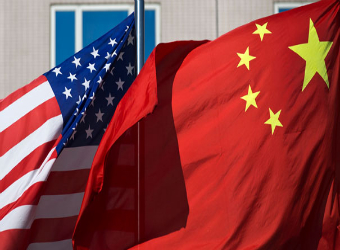The United States advised its commercial airlines to notify Chinese authorities of flight plans when travelling through an air defense zone that Beijing established a week ago over the East China Sea, ratcheting up regional tensions.
The United States said it expected U.S. carriers to operate in line with so-called notices to airmen issued by foreign countries, adding, however, that the decision did “not indicate U.S. government acceptance of China’s requirements.
The advice is in contrast with America’s close ally Japan, where the two major airlines have agreed with the Japanese government to fly through the zone without notifying China.
Beijing wants foreign aircraft passing through the zone – including passenger planes – to identify themselves to Chinese authorities.
A U.S. administration official said China’s action appeared to be a unilateral attempt to change the status quo in the East China Sea, which could “increase the risk of miscalculation, confrontation and accidents”.
“We urge the Chinese to exercise caution and restraint, and we are consulting with Japanand other affected parties throughout the region,” the official said.
The zone includes skies over islands at the heart of a tense territorial dispute between Japanand China and represents a historic challenge by the emerging new world power to the United States, which has dominated the region for decades.
U.S. Vice President Joe Biden is due to visit China, Japan and South Korea next week, and will try to ease tensions over the issue, senior U.S. officials said.
Defying China’s declaration of the air defence zone, the United States, Japan and South Korea flew military aircraft through the area this week without informing Beijing.
On Friday, China scrambled jets after two U.S. spy planes and 10 Japanese aircraft, including F-15 fighters, entered the zone, China’s state news agency Xinhua said. The jets were scrambled for effective monitoring, it quoted air force spokesman Shen Jinke as saying.
The Chinese patrol mission, conducted on Thursday, was “a defensive measure and in line with international common practices”, Shen said, according to Xinhua.
“China’s air force is on high alert and will take measures to deal with diverse air threats to firmly protect the security of the country’s airspace,” he said.
However, Defence Ministry spokesman Yang Yujun said it was “incorrect” to suggest China would shoot down aircraft which entered the zone without first identifying themselves. He did not elaborate.
U.S. flights were “routinely” transiting the zone, U.S. officials said on Friday. Flights this week included a training mission for two unarmed B-52 bombers.
“These flights are consistent with long standing and well known U.S. freedom of navigation policies,” Pentagon spokesman Colonel Steve Warren said. “I can confirm that the U.S. has and will continue to operate in the area as normal.”
A U.S. defence official said the routine operations included reconnaissance and surveillance flights.
STRAINED TIES
In a further sign of Tokyo’s defiance, Japanese carriers ANA Holdings and Japan Airlines have flown through the zone without informing China. Neither airline experienced any problems.
The airlines said they were sticking with that policy even after Washington advised U.S. commercial airlines to notify China when they fly through the zone, although an ANA spokesman said his airline would follow whatever advice the government provided.
China’s Foreign Ministry said on Thursday there had been no impact on the safe operation of international civilian flights since the zone had come into force, although China “hoped” airlines would co-operate.
Ties between China and Japan have been strained for months by the dispute over the islands, called the Diaoyu by China and the Senkaku by Japan.
Mutual mistrust over military intentions and what China feels is Japan’s lack of contrition over its brutal occupation of parts of China before, and during, World War Two have added to tension.
“It’s important for both sides to take a calm approach and deal with the situation according to international norms,” Japan’s Defence Minister, Itsunori Onodera, told state broadcaster NHK on Saturday. Onodera said the Japanese military had not noted any Chinese aircraft in the zone.
Although Washington takes no position on the sovereignty of the islands, it recognises Tokyo’s administrative control and says the U.S.-Japan security pact applies to them.
Europe’s top diplomat, Catherine Ashton, said the European Union was concerned about China’s decision to establish the new air defence zone as well as its announcement of “emergency defence measures” if other parties did not comply.
“This development heightens the risk of escalation and contributes to raising tensions in the region,” Ashton said. “The EU calls on all sides to exercise caution and restraint.”
CRITICISM
China’s Foreign Ministry spokesman Qin Gang criticised Ashton’s remarks, saying China hoped the EU could treat the situation “objectively and rationally”.
“Actually, Madam Ashton should know that some European countries also have air defence identification zones,” Qin said. “I don’t know if this leads to tensions in the European regional situation. European countries can have air defence identification zones. Why can’t China?”
Although there are concerns over the increased tensions, the United States and China have stepped up military communication in recent years to avoid accidental clashes.
The Global Times, an influential tabloid published by the ruling Communist Party’s official People’s Daily newspaper, praised the government for its calm response in the face of “provocations”, saying China would not target the United States in the zone as long as it “does not go too far”.
But it warned Japan it could expect a robust response if it continued to fly military aircraft in the zone.
“If the trend continues, there will likely be frictions and confrontations and even a collision in the air … It is therefore an urgent task for China to further train its air force to make full preparation for potential conflicts,” it wrote in an editorial on Friday.
Source: Reuters



